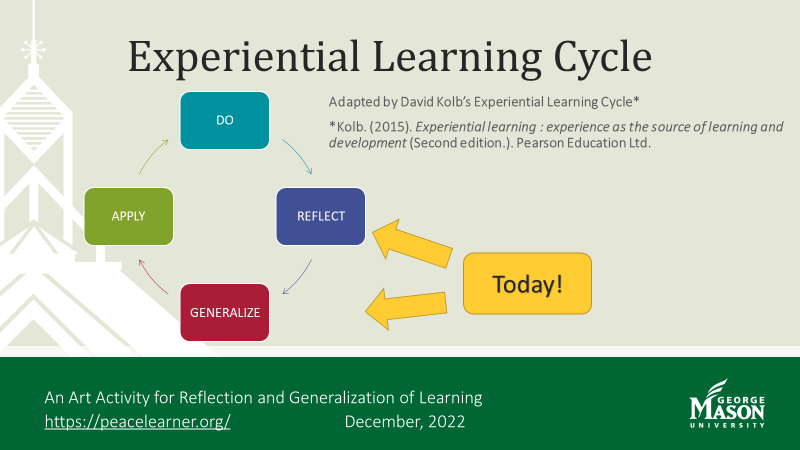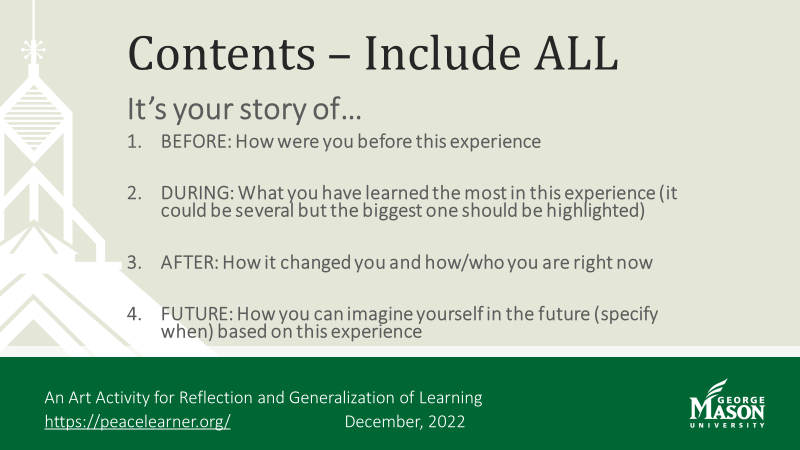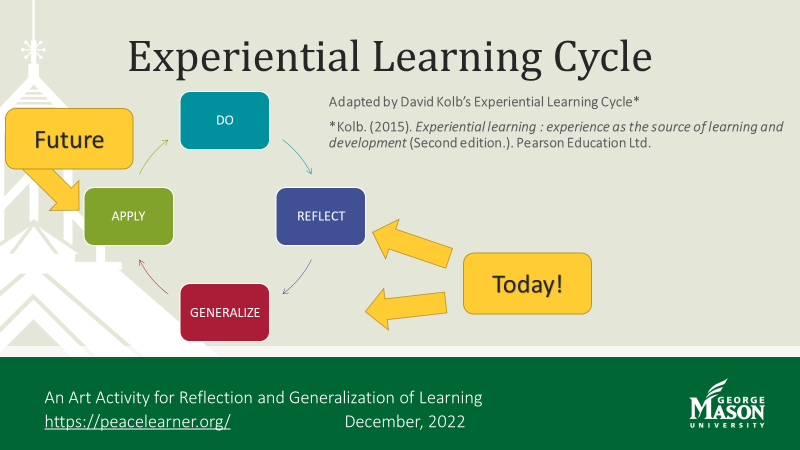Designed by Yuriko Noda
This is an activity designed and can be utilized effectively at the end of a series of training, seminar, course, etc. that is conducted based on the principles of experiential learning which facilitates participants learning through their experiences.
Based on the experiential learning cycle adapted from Kolb (2015), it is argued that people can learn from experiences, but just experiencing something is not enough to actually learn from it. For the effective experiential learning, the process of “Reflection” and “Generalization” are important in order to be able to “Apply” the learning in the future. Therefore, this activity is designed to be helpful for participants to reflect and generalize their learning from their experiences.

Outline of the activity:
- Overview: The participants take time to work on their own to reflect their series of experiences, make a short story about it, and put it into an art piece. After that, the participants present it to the group, and the facilitator lead a short discussion about each presentation with the group, as well as a short reflection about this entire activity.
- Time: 45-60 minutes
- Number of participants: Any number more than 3
- Age group: Any age, depending on the expected depth of the reflections, generalizations, and discussions
- Settings: In-person or online.
- For in-person settings, a variety of materials need to be prepared.
- For online settings, it’s helpful to notify the participants in advance so that they can bring their own materials ready.
- Goals: By the end of this activity, the participants would be able to
- Become more aware of their biggest learning from the series of experiences
- Express and present their biggest learning from the series of experiences
- Have ideas how to apply their biggest learning from the series of experiences in their future
- Remember their biggest learning from the series of experiences even after the completion
- Pre-Work:
- This 45–60-minutes activity is designed to be conducted after each participant taking time to reflect their series of experiences. So it is recommended to either give them heads-up to reflect the experiences on their own or set time for reflection together before this activity.
- If it’s conducted online, it is also helpful to tell the participants briefly what we are going to do, and ask them to bring materials they may want to use (paper, pens, musical instruments, etc.).
- Flow and instructions:
- Introduction (1 min): Why we are doing this activity (purpose).
- Presenting the learning cycle of DO – REFLECT – GENERALIZE – APPLY from the experiential learning, explain that this activity will help their reflection and generalization process of their learning and their preparation for application. DO part should have been done during the series of experiences.
- Motivate them to try to grab the most important learning and express it in the form of art.
- Instructions (4 min):
- You will have 10 minutes to work on your piece of art by yourself. You are going to think and express the followings in a form of art, and present with the group after that (how to present, time to present depends on the number of the participants).
- You can use any form of art. It could be a little one-man sketch or skit, making a song, rewriting lyrics of a famous song, drawing a picture, drawing a poster, making a sculpture using what you have at hand, write a poem, etc. But please try to avoid long sentences or wordy explanations. Using hands like handwriting is encouraged rather than typing or drawing on computer. Be creative!
- Contents of the art is like a story which should include ALL of the following:
- BEFORE: How were you before this experience
- DURING: What you have learned the most in this experience (it could be several but the biggest one should be highlighted)
- AFTER: How it changed you and how/who you are right now
- FUTURE: How you can imagine yourself in the future (specify when) based on this experience
- Time to work by yourself is 10 minutes. Time for you to present is 2 minutes. The facilitator will give you reminders of time (5 minutes to go, 1 mininute to go).
- Any questions?
- Individual crafting time (10-15 min). Playing a nice music is a good option. Set a timer and facilitator will give reminders 5 minutes and 1 minute before the end.
- Presentation and discussion (20 min):
- We get together after the crafting time is over.
- Some or all of the partiicpants present their art pieces.
- After each person’s presentation, other participants are welcome to make short comments, if any.
- Facilitator will also acknowledge and make a comment on the presentation.
- Small reflection of this activity (5 min):
- Open to the floor to share their reflections and learning (if any) of this activity.
- Wrap up (5 min):
- Show appreciation for their works and make a brief comment by the facilitator
- Put up the learning cycle again to highlight that in the experiential learning, it starts with DO but through the process of REFLECT and GENERALIZE, the learners can bring their learning as transferable or applicable knowledge, skills or attitudes. That’s why we did this activity and hope it will be helpful for you to utilize or apply your learning (not only the biggest one but other small ones, too) in your life in the future in different contexts
- Introduction (1 min): Why we are doing this activity (purpose).


Resource:
Kolb. (2015). Experiential learning : experience as the source of learning and development (Second edition.). Pearson Education Ltd.
*This activity was designed by Yuriko Noda, a PhD stuent at from Jimmy and Rosalynn Carter School for Peace and Conflict Resolution, George Mason University
